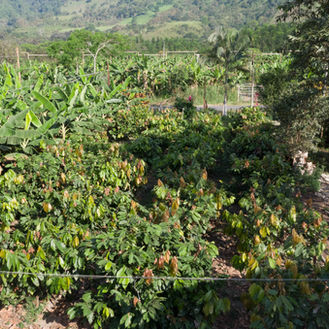

4 hours ago6 min read
Updated: Nov 7, 2024

Smart farming, also known as precision agriculture, is an innovative approach to agriculture that utilizes technology, data, and advanced techniques to optimize farming practices and increase productivity while minimizing resource wastage (1). One of the key technologies often integrated into smart farming is a geographic information system (GIS), which helps map legal land for agriculture, provides supply chain transparency, and makes it easier for producers to make decisions related to farm management.

Geographic Information System (GIS) is a powerful tool for capturing, storing, analyzing, managing, and presenting spatial and visualizing data related to geographical aspects such as location, topography, and other environmental variables. GIS can enhance decision-making processes and overall farm management in the agriculture sector. GIS assists agribusinesses and smallholder producers in optimizing existing natural resources, such as water, soil, and weather. Using GIS, they can identify spatial patterns within agricultural land, classify soils based on their quality, and map water and nutrient requirements within agricultural areas. With accurate mapping, GIS enables better decision-making in crop planning, pest and disease control, and natural resource management.
Additionally, Geographic Information Systems (GIS) enable agribusinesses and smallholders to collect geographic data about an area and map that information visually. GIS maps and identifies various aspects of land, such as land boundaries, soil types, topography, land use, and existing natural resources.
Using Geographic Information Systems (GIS) provides a few significant benefits, i.e., increasing interest in and awareness of its economic and strategic value as a standards-based technology. Following are some of the benefits of implementing GIS in the agricultural sector:
Cost efficiency: Using GIS in agriculture can result in cost efficiency by increasing the efficiency of farming processes and the management of land resources.
Better decision-making: GIS helps agribusinesses and smallholder producers make better decisions about their farms by providing accurate and up-to-date data and information.
Improved communication: GIS-based maps and visualizations help producers understand land conditions better and improve communication between producers, agricultural experts, government, and analysts.
Better geographic information: GIS provides accurate and comprehensive geographic information, enabling in-depth analysis of factors affecting agricultural productivity.
Effective planning: GIS enables effective planning in land resource management and optimal use of natural resources, increasing agricultural productivity and sustainability.
Accurate location: GIS utilizes geo-location technology to determine the geographic position of various agricultural entities, such as fields, plantations, or farm buildings. This helps agribusinesses and smallholder producers accurately identify and classify areas.

Koltiva applies Geographic Information System (GIS) technology integrated into our traceability platform, KoltiTrace platform, to ensure verified supply chain sustainability with high transparency. By combining GIS data and geo-location features, we can generate accurate and valid information regarding the location and status of agricultural land. Through the presence of a trained field team, verified human-centered data is collected to ensure that the farmland used has passed the appropriate verification process. KoltiTrace also supports supply chain visualization via QR Code scanning, providing quick and easy access to track product journeys from seed to table. With this approach, Koltiva ensures that its verified agricultural supply chain is reliable and meets sustainability standards, giving customers confidence in the origin of its products and the agricultural practices used.
Applying GIS technology to the KoltiTrace platform, Koltiva has confirmed its commitment to ensuring a transparently verified agricultural supply chain. Through integrating GIS data, geo-location features, and supply chain visualization, Koltiva gives confidence to customers that the agricultural products they consume come from verified land and are managed with high sustainability standards. With a focus on data accuracy, validity, and integrity, we provide tools to ensure product quality and strengthen the sustainability of agricultural supply chains. Koltiva continues to drive innovation and technology adoption to create a better future for agriculture.
Incorporating GIS into smart farming practices requires a combination of hardware (such as GPS devices) and software tools that allow for data collection, integration, analysis, and visualization. As technology advances, the synergy between smart farming and GIS will likely play an even more significant role in transforming agriculture and addressing the challenges of feeding a growing global population while promoting sustainability.
----------------------------------
References :
Writer: Rihlah Bilkis, Social Media at Koltiva
Contributor: Wikha Jily, Lead GIS Developer at Koltiva
Editor: Boby Hermawan, Head of Digital Marketing at Koltiva
About the Writer:
Rihlah Nahdhiyah Bilkis, a skilled writer with a social media and copywriting background, excelled as a social media specialist at Koltiva, crafting captivating articles on products and producers stories for the company's blog, showcasing her unique ability to blend technical details with human narratives. Her strategic approach to social media has been instrumental in connecting with the audience, making her a promising talent in content creation.
Exciting to see how technology like GIS is shaping the future of agriculture.
The article is truly insightful, shedding light on how GIS is transforming agriculture.
GIS bringing high-tech solutions to farming, it's like a digital revolution for agriculture!
Insightful article!